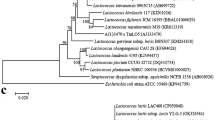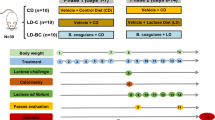Abstract
The endogenous β-galactosidase expressed in intestinal microbes is demonstrated to help humans in lactose usage, and treatment associated with the promotion of beneficial microorganism in the gut is correlated with lactose tolerance. From this point, a kind of recombinant live β-galactosidase delivery system using food-grade protein expression techniques and selected probiotics as vehicle was promoted by us for the purpose of application in lactose intolerance subjects. Previously, a recombinant Lactococcus lactis MG1363 strain expressing food-grade β-galactosidase, the L. lactis MG1363/FGZW, was successfully constructed and evaluated in vitro. This study was conducted to in vivo evaluate its efficacy on alleviating lactose intolerance symptoms in post-weaning Balb/c mice, which were orally administered with 1 × 106 CFU or 1 × 108 CFU of L. lactis MG1363/FGZW daily for 4 weeks before lactose challenge. In comparison with naïve mice, the mice administered with L. lactis MG1363/FGZW showed significant alleviation of diarrhea symptoms in less total feces weight within 6 h post-challenge and suppressed intestinal motility after lactose challenge, although there was no significant increase of β-galactosidase activity in small intestine. The alleviation also correlated with higher species abundance, more Bifidobacterium colonization, and stronger colonization resistance in mice intestinal microflora. Therefore, this recombinant L. lactis strain effectively alleviated diarrhea symptom induced by lactose uptake in lactose intolerance model mice with the probable mechanism of promotion of lactic acid bacteria to differentiate and predominantly colonize in gut microbial community, thus making it a promising probiotic for lactose intolerance subjects.







Similar content being viewed by others
References
Avaniss-Aghajani E, Jones K, Holtzman A, Aronson T, Glover N, Boian M, Froman S, Brunk CF (1996) Molecular technique for rapid identification of mycobacteria. J Clin Microbiol 34:98–102
Chen CS, Hsu CK, Chiang BH (2002) Optimization of the enzymic process for manufacturing low-lactose milk containing oligosaccharides. Process Biochem 38:801–808
Corthésy B, Boris S, Isler P, Grangette C, Mercenier A (2005) Oral immunization of mice with lactic acid bacteria producing Hdlicobacter pylori urease B subunit partially protects against challenge with Helicobacter felis. J Infect Dis 192:1441–1449
Farnworth ER (2008) The evidence to support health claims for probiotics. J Nutr 138:1250S–1254S
Guo XH (2002) Fundamentals and applications of probiotics. Beijing Science and Technology Press, Beijing
Harrington LK, Mayberry JF (2008) A re-appraisal of lactose intolerance. Int J Clin Pract 62:1541–1546
He M, Yang YX (1999) Lactase deficiency and lactose intolerance. Foreign Med Sci-Hygiene 6:339–342
He W, Lü B, Huang C (2005) Lactase and its gene regulation in BALB/c mice at different ages. Sichuan Da Xue Xue Bao Yi Xue Ban 36:516–518
Heyman MB, Committee on Nutrition (2006) Lactose intolerance in infants, children, and adolescents. Pediatrics 118:1279–1286
Horner TW, Dunn ML, Eggett DL, Ogden LV (2011) β-Galactosidase activity of commercial lactase samples in raw and pasteurized milk at refrigerated temperatures. J Dairy Sci 94:3242–3249
Kopp-Hoolihan L (2001) Prophylactic and therapeutic uses of probiotics: a review. J Am Diet Assoc 101:229–238, quiz 239-241
Li W, Zhang XM, Lu Y (2004) Lactose intolerance and the development of low-lactose milk. China Dairy 2:35–37
Marsh TL (2005) Culture-independent microbial community analysis with terminal restriction fragment length polymorphism. Methods Enzymol 397:308–329
Masood MI, Qadir MI, Shirazi JH, Khan IU (2011) Beneficial effects of lactic acid bacteria on human beings. Crit Rev Microbiol 37:91–98
Novalin S, Neuhaus W, Kulbe KD (2005) A new innovative process to produce lactose-reduced skim milk. J Biotechnol 119:212–218
Osborn AM, Moore ERB, Timmis KN (2000) An evaluation of terminal-restriction fragment length polymorphism (T-RFLP) analysis for the study of microbial community structure and dynamics. Environ Microbiol 2:39–50
Savaiano D (2011) Lactose intolerance: an unnecessary risk for low bone density. Nestle Nutr Workshop Ser Pediatr Program 67:161–171
Si JM, Yu YC, Fan YJ, Chen SJ (2004) Intestinal microecology and quality of life in irritable bowel syndrome patients. World J Gastroenterol 10:1802–1805
van de Guchte M, van der Vossen JM, Kok J, Venema G (1989) Construction of a lactococcal expression vector: expression of hen egg white lysozyme in Lactococcus lactis subsp. lactis. Appl Environ Microbiol 55:224–228
van de Guchte M, Kodde J, van der Vossen JM, Kok J, Venema G (1990) Heterologous gene expression in Lactococcus lactis subsp. lactis: synthesis, secretion, and processing of the Bacillus subtilis neutral protease. Appl Environ Microbiol 56:2606–2611
Wang C, Zhang CW, Liu HC, Yu Q, Pei XF (2008) Non-fusion and fusion expression of β-galactosidase from Lactobacillus bulgaricus in Lactococcus lactis. Biomed Environ Sci 21:389–397
Wu ZW, Li LJ, Ma WH, Yu YS, Chen YG (2000) A new index for microbial colonization resistance of the bowel—the ratio of B/E. Zhe Jiang Yu Fang Yi Xue 7:4–5
Xu Y, Wu XY, Lu YQ (2008) Study on lactose intolerance. Acad Period Farm Prod Process 11:89–91
Yang Y, He M, Cui H, Bian L (1999) Study on the incidence of lactose intolerance of children in China. Wei Sheng Yan Jiu 28:44–46
Zhang W, Wang C, Huang CY, Yu Q, Liu H, Zhang C, Pei X (2011) Construction and expression of food-grade β-galactosidase gene in Lactococcus lactis. Curr Microbiol 62:639–644
Zhong Y (2003) Probiotic and the study of the lactose intolerance. Foreign Med Sci-Hygiene 2:101–105
Acknowledgment
This study was supported by funds from the National Science Foundation of China (grant no. 30800910).
Author information
Authors and Affiliations
Corresponding authors
Additional information
Jingjie Li and Wen Zhang contributed equally to this work.
Rights and permissions
About this article
Cite this article
Li, J., Zhang, W., Wang, C. et al. Lactococcus lactis expressing food-grade β-galactosidase alleviates lactose intolerance symptoms in post-weaning Balb/c mice. Appl Microbiol Biotechnol 96, 1499–1506 (2012). https://doi.org/10.1007/s00253-012-3977-4
Received:
Revised:
Accepted:
Published:
Issue Date:
DOI: https://doi.org/10.1007/s00253-012-3977-4




